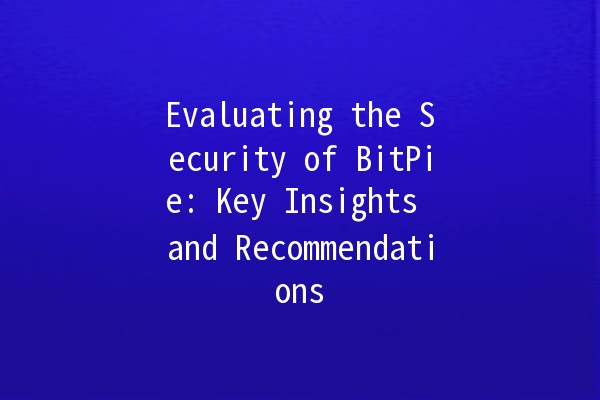




In the rapidly evolving world of cryptocurrency, security remains a paramount concern. BitPie, a digital wallet catering to users looking to manage their crypto assets, has garnered attention for its unique security features. This article delves into a comprehensive evaluation of BitPie’s security measures, offering practical insights and tips for users concerned about safeguarding their digital wealth.
In this discussion, we will explore the technological safeguards that BitPie employs, the potential vulnerabilities that users should be aware of, and actionable strategies to enhance their overall asset security.

BitPie employs robust encryption protocols to secure user data and assets. At its core, the wallet uses advanced cryptographic algorithms that ensure that private keys — essential for accessing and managing cryptocurrencies — are stored in an encrypted format. This means that even if a potential attacker gains access to the device, the encrypted keys remain protected.
Example Application: Users can enhance security by ensuring that their devices and applications are always up to date, thereby minimizing vulnerabilities experienced in older software versions.
Another notable security feature of BitPie is its support for multisignature (multisig) transactions. This functionality requires multiple private keys to authorize a transaction, adding an extra layer of security. For businesses or highnetworth individuals managing substantial crypto portfolios, implementing multisig can help prevent unauthorized transactions.
Example Application: Users should consider setting up a multisig wallet for collaborative management, wherein multiple stakeholders must approve significant transactions.
BitPie routinely conducts security audits to identify potential vulnerabilities in their systems. These audits help in maintaining the integrity of the wallet and ensuring compliance with industry best practices. Regular updates are rolled out to patch any identified vulnerabilities promptly, ensuring that users benefit from the latest security enhancements.
Example Application: Users should subscribe to BitPie’s official communications for updates and news about security enhancements and participate in audits’ feedback whenever possible.
Here are five essential tips for BitPie users to enhance their wallet security further:
Activating twofactor authentication (2FA) is critical in strengthening account security. 2FA requires an additional verification step beyond just the password to access the wallet. This can typically be achieved through a mobile authentication app.
Application: Always enable 2FA for any service that supports it to provide layered protection against unauthorized access.
For those holding significant amounts of cryptocurrency, transferring assets to a hardware wallet for offline storage is advisable. Hardware wallets offer greater security by keeping private keys offline, making them immune to online hacking attempts.
Application: Utilize hardware wallets to store the bulk of your cryptocurrency while using BitPie for smaller transactions to ensure daytoday liquidity.
Phishing scams often target crypto users, with malicious actors attempting to trick individuals into revealing confidential information. Always verify the authenticity of communications and avoid clicking on suspicious links.
Application: Familiarize yourself with common phishing tactics and practice caution when interacting with emails or messages regarding wallet activities.
BitPie offers users the option to backup their wallet data. Regular backups not only protect against data loss due to device failure but also ensure access in case your device is lost or stolen.
Application: Schedule a routine (monthly or quarterly) to back up your BitPie wallet and store the backup in a secure location.
The cryptocurrency landscape is continually evolving, with new threats arising from technology advances and changing regulatory frameworks. Staying informed about the latest security threats can help you adapt and protect your assets effectively.
Application: Follow reputable blockchain and cryptocurrency news outlets to remain updated on potential threats and security best practices.
Using any digital wallet, including BitPie, comes with inherent risks. These include the potential for hacking, malware attacks, and user negligence. It is vital for users to employ best practices to mitigate these risks actively.
BitPie encrypts private keys, but user vigilance is crucial. The security of these keys largely depends on user behavior and device security. Always ensure that your device is free from malware and is protected with updated antivirus software.
Yes, BitPie provides recovery options through backup seeds. It is crucial to store these backup phrases securely. Without them, users may permanently lose access to their assets if they forget their passwords or lose their device.
BitPie strives to align with the latest regulatory standards and best practices. Users should check for any regional compliance notifications and adjust their usage based on local legal guidance.
While using a wallet like BitPie adds a security layer by enabling users to control their private keys, it is essential to only use reputable exchanges when transferring assets. When assets are held on exchanges, they are still at risk of compromise.
If you suspect any compromise, immediately change your password and enable 2FA. Transfer funds to a new wallet if you feel your private keys may have been exposed, and monitor your accounts for unauthorized transactions.
The security of your cryptocurrency assets is paramount, and while BitPie offers numerous builtin security features, users must take proactive measures to protect their investments. With the tips outlined and an understanding of BitPie’s security architecture, users can navigate the cryptocurrency landscape with confidence.
By staying vigilant, practicing digital hygiene, and being informed about emerging security threats, users can significantly enhance their protection while leveraging BitPie’s digital wallet for their crypto management needs.